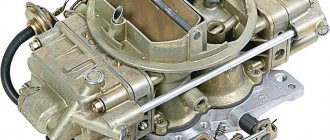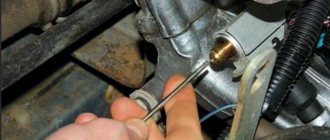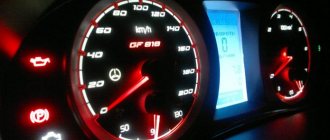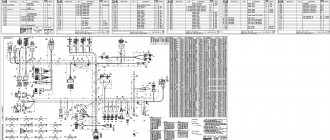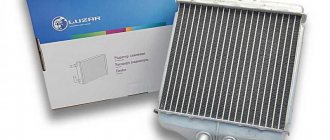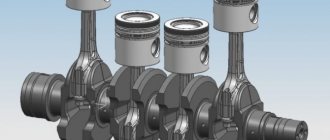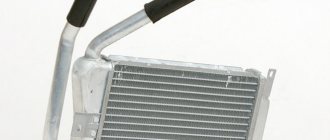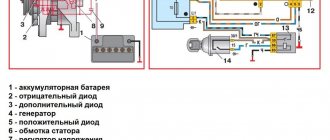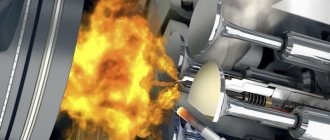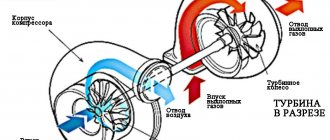Since the heater is not used in the summer, problems with the stove appear with the onset of cold weather, which causes a lot of problems for the driver and passengers. Is it possible to independently determine the cause of the malfunction and try to eliminate it? As practice shows, the answer to this question is generally positive - most problems can indeed be solved without resorting to the services of professionals, but subject to accurate diagnosis of the causes of the breakdown, and there can be a lot of them.
Solving problems with the Audi 80 stove.
How does the Audi 80 heating system work?
The operating principle of a German car heater is not fundamentally different from the operating diagram of the ventilation/heating system of any modern car. As you know, an engine is a source of large amounts of heat generated due to the friction of rotating parts, the operation of pistons and the combustion of the fuel mixture. To prevent the power unit from overheating, it must be forcibly cooled. For this, a cooling system is used, consisting of a radiator and a system of tubes through which water circulates through the system and takes heat from the engine, being cooled by the flow of oncoming air in the radiator installed at the front of the car.
There is another radiator on the opposite side of the engine compartment, and it already belongs to the heating system. During the warm season, it is inactive, and when the heater turns on, hot water from the power unit first rushes into the heater radiator, heating its tubes, which give off heat to the air. Thus, hot air, with the help of a fan, enters the cabin through a system of nozzles and deflectors, allowing the flow of warm air to be directed to the right place, including the windshield and side windows of the car.
A malfunction of any component of the heating system (as well as part of the cooling system) leads to insufficiently heated or even cold air entering the cabin, that is, the Audi 80 heater blows cold or barely warm air.
Heater device
On Audi 80 cars, the heater is designed extremely simply, regardless of the body type in front of you. B3 and B4 have approximately the same circuit, therefore the design of the Audi 80 stove is considered identical.
This greatly facilitates independent repairs and finding faulty elements without outside help. Audi 80 cannot be considered ideal cars in terms of self-service, since some stages of repair are objectively difficult to cope with.
Although this statement does not apply in any way to the heating system of a German vehicle. If we talk about the design and layout of the stove on the Audi 80 B3 and B4, then these cars include:
- heat exchanger, that is, radiator;
- body consisting of 2 halves;
- mounting bracket;
- connection board with resistor;
- fresh air dampers;
- temperature dampers;
- electric fan;
- air ducts;
- tubes and pipes;
- electric fan fuse.
As for the malfunction of the Audi 80 stove, in most cases this is due to the controls located in the cabin, the radiator or the electric fan.
Symptoms and causes of malfunctions of the Audi 80 heating system
The main sign of problems with interior heating is the lack of warm or hot air blowing if the heater faucet, which allows antifreeze access to the radiator and the entire heating system circuit, is completely open. As we have already noted, there are many reasons for this, but they can all be classified through several categories:
- complete inoperability (no air comes from the deflectors at all),
- air comes in, but is cold or not warm enough,
- The stove cannot operate in one or more modes.
To restore the functionality of the heating system, it is necessary to find out why the Audi 80 stove does not heat well, that is, to diagnose it. Normally, after starting the engine and starting to drive, 10 to 15 minutes later the heater should provide good heating of the interior - this time is enough for the power unit to reach operating parameters. If, after 15 minutes, cold air comes from the deflectors or no flow is felt at all, and the glass from the inside is covered with frost or intensely fogged up, it is necessary to urgently look for the cause.
Insufficient coolant level
Among the reasons for insufficient interior heating efficiency, the most common is a lack of coolant, especially on older cars. Many modern cars are equipped with a sensor that monitors the level of antifreeze in the system and signals its critical decrease, but it is far from a fact that your model belongs to the latest generation. If there is not enough coolant in the system, the heater radiator does not heat up intensively enough, so the efficiency of the heater is noticeably reduced. Warm air enters the cabin, but in maximum heating mode it continues to remain the same, not providing heating of the cabin when the outside temperature drops significantly. Adding antifreeze is quite simple, but without identifying and eliminating the reasons for its loss, the problem will certainly appear again. If the leak is significant, it will happen quickly.
The cause of depressurization of the circuit may be damage to the radiator or pipes, as well as leaks at the junction of the hoses and pipes. A leak can be detected by the presence of smudges that form under the car after it has been parked for a long time. Eliminating a coolant leak is also not particularly difficult, unless it is a radiator leak - in this case, it is necessary to accurately determine the location of the leak, and if it is in a hard-to-reach place, the radiator will have to be removed. Soldering the defect allows you to solve the problem, but this process has its own nuances, and if you have never held a soldering iron in your hands, entrust the repair to a more experienced technician.
Air jams
Another common reason for a noticeable deterioration in interior heating is airiness in the cooling system. Air usually enters the circuit after a complete replacement of antifreeze, less often when refilling with antifreeze. Deterioration in interior heating is by no means the only consequence of the appearance of an air lock - it prevents the free flow of antifreeze along the circuit, and if a lot of air gets into the system, the coolant will stop circulating altogether. This is fraught with overheating of the power unit, which is much more dangerous than a decrease in the efficiency of heating the interior.
If the Audi 80 B3 stove does not work due to airiness in the system, there are many ways to eliminate the airlock, and all of them can be done independently (the presence of an assistant may be required).
Heater core clogged
If no deviations are found when checking the antifreeze level, the lack of heat on the deflectors may be caused by a clogged heater core. This is generally a normal phenomenon for older cars, but sometimes the cause of a clogged radiator grill is the use by the car owner of various powder preparations designed to eliminate coolant leaks. That is, by eliminating one reason for the deterioration of the car’s heating system, we get another. Such sealants tend to clog passages in radiator pipes, especially if you used the drug without following the instructions (used a larger dosage than recommended).
A clogged radiator can be caused by mixing different brands of coolant (for example, if you filled it with antifreeze and topped it with G11 or G13 antifreeze). In this case, a sediment forms, gradually settling on the walls of the radiator tubes and reducing the clearance for coolant circulation.
The same effect is achieved by using ordinary water - it is not only a source of corrosion, but also contains various salts, which, when in a heated liquid, precipitate, forming scale on the radiator tubes. If the heater on an Audi 80 B3 does not work due to a clogged fan, there are several ways to fix the problem:
- Some experienced motorists recommend swapping the inlet and outlet hoses of the heater radiator. The fact is that when liquid flows in one direction, deposits accumulate in layers, resembling fish scales. By changing the hoses, you will change the direction of movement of the antifreeze, and some of the deposits will probably be washed away, which will manifest itself in improved heating efficiency (however, these pollutants will not be removed from the system and over time will certainly settle somewhere else, if not done after some time replacing antifreeze).
- The most common, but not always effective method is flushing the system with a special solution (or powder added to antifreeze). For the effect to be acceptable, the engine needs to work with this liquid for a long time, which most car owners cannot afford.
- Another way to solve the problem is to install a used radiator. True, it may not be in perfect condition either, but there is a good way to determine how clogged it is - measure its weight. The smaller it is (ideally equal to the weight of the new one), the better. Carefully examine the radiator for signs of leaks - in this case, it is better to refuse the purchase.
- If cleaning the radiator or flushing the system with special preparations did not solve the problem, and a used one of acceptable quality could not be found, you will have to buy and install a new heater radiator. Usually this most radical method guarantees the disappearance of problems.
Fan doesn't work
The lack of air flow from the deflectors is a clear sign that the stove fan is not working at all. At the same time, the coolant will continue to wash the radiator, the heat exchange process will not stall, but the heated air will flow into the cabin only by gravity, that is, barely.
If the Audi 80 B 2 stove does not heat up and you are sure that the fan does not spin, you need to check the integrity of the 30-amp fuse F17, which is responsible for the power supply circuit of the electric motor of the fan. If you find that it has burned out, do not rush to install a new one: there may be damage to the electrical wiring that has caused a short circuit. In this case, installing a new fuse will again lead to its blowout. Test the appropriate circuit with a multimeter or tester.
It happens that the fan does not work in all modes. The fact is that when the maximum heating mode is turned on, it operates directly from the on-board network, and in other modes the fan is powered through resistors that reduce its speed. If one of these resistors fails, the corresponding mode will stop turning on.
The cause of resistor burnout is a short-term increase in load on the impeller (fan blades). By replacing the resistor with a regular wire jumper, you can partially solve the problem - the fan in this mode will start working again, but at maximum power. Another reason for the fan not working in certain modes may be oxidation of the contacts on the gear shift knob. Access to it can be opened after removing the radio.
Thermostat is faulty
If the problem is not the malfunctions described above, then the cause of insufficient heating of the interior may be a malfunction of the power unit thermostat. The purpose of the thermostat is to warm up the engine as quickly as possible. When the antifreeze temperature is less than 95 degrees, it blocks coolant access to the front radiator, that is, the liquid circulates in a “small circle” through the heater radiator. With a shorter distance, the antifreeze does not have time to cool down and heats up faster. As soon as its temperature rises to operating temperature, the thermostat will close the “small circle”, allowing coolant to flow through the radiator of the cooling system, preventing the engine from overheating.
But due to poor quality antifreeze or due to natural wear and tear, the thermostat may stop performing its functions - in this case, the coolant will always circulate in a “large circle”. In this case, it takes a very long time to heat up to 95 degrees, which is why it will be cold in the cabin for a long time.
If the Audi 80 B3 stove does not heat up, the reason may be that the “small circle” is only partially overlapped, and then even at maximum fan speed, insufficiently heated air will enter the cabin. When the temperature outside is minus 20 - 30 degrees, even during a long trip with a faulty thermostat, the antifreeze will not be able to warm up to operating temperature. The problem can only be fixed by replacing the thermostat with a new one - it cannot be repaired. And you can do this as quickly as possible - otherwise, you simply will not be able to drive in the cold season due to fogged or ice-covered windows.
Pump faulty
The main purpose of the pump is to ensure the movement of coolant through the cooling system (from the engine block through the pipes to the radiator and then again to the power unit). The pump is a mechanical pump in the form of an impeller that pushes liquid through a cylinder through the system. The pump is driven by a belt drive that transmits rotation from the crankshaft. If this belt breaks, the pump stops rotating. So if the Audi 80 B4 stove does not heat, this may be the reason, and the pump’s inoperability can lead to rapid overheating of the power unit.
Sometimes the pump impeller itself jams (as a result of bearing scattering or foreign objects entering the pump cavity). Sometimes the impeller, if it is made of low-quality metal, is simply corroded by antifreeze containing aggressive components - in this case, although the pump will rotate, the pressure created will be noticeably lower, which will also affect the efficiency of the heater. It is easy to diagnose a pump malfunction - this may be indicated by the appearance of a whistle in the engine compartment. You can touch the hose that goes to the pump with your hands - if it is hot at the inlet and cold at the outlet, then the problem is in this unit. As with the thermostat, the solution to the problem is to replace the pump.
The power unit cylinder head gasket is broken
Violation of the integrity of the head gasket is a common occurrence, usually occurring due to poor tightening. In such cases, coolant will flow into the cylinders or into the exhaust system (in the latter case, this will be indicated by thick white smoke coming from the muffler). If the Audi 80 B3 stove does not heat well due to a decrease in the amount of coolant in the system, this is a serious problem that also affects the rapid warming up of the engine to temperatures above operating temperatures. If this problem is identified, you must immediately replace the gasket, otherwise the motor may overheat and fail.
Cabin filter dirty
If the cabin filter installed in front of the deflectors is thoroughly clogged, this will prevent the normal flow of heated air into the cabin. Some drivers simply get rid of it, but this is not recommended unless, of course, you value your health. Changing the cabin filter is an extremely simple operation that requires the ability to work with a screwdriver. Considering that today you can purchase filters that protect not only from dust, but also from the penetration of unpleasant odors into the cabin, you should abandon the idea of throwing it away.
Duct offset
This reason for the insufficient efficiency of interior heating can be called exotic, but it occurs, especially on very old cars and vehicles that have been in an accident. You can try to fix the problem by installing the air ducts in their original place and securing them with plastic clamps. If it doesn’t work, replace them with new ones.
As you can see, there are really many reasons why the Audi 80 B4 stove does not heat well, and if there are no very specific symptoms, determining the exact cause can be very troublesome. In any case, most problems can be fixed on your own, without visiting a service station or car service center.
Scheme of work
To ensure that fresh air enters the interior of the Audi 80 B3 or B4, a ventilation system is used for this. The air flows around the stove body and, due to the presence of special dampers, enters the outlet nozzles.
When the heating system is set to heating mode, the cold air coming from the external environment is heated. This is provided by the radiator of the heating system, which is heated by the engine coolant.
The stove radiator itself is located inside the heating system housing. The fresh air that flows through the unit is heated by the hot sections of the radiator, after which the heated air ends up inside the cabin.
In Audi 80 cars in B3 and B4 bodies, interior heating is controlled by the air method. That is, the driver sets the temperature based on the ratio of hot and cold air. For such tasks, a control unit with a temperature damper regulator is provided here.
It is important to note that the heater on the Audi 80 involves the use of a four-stage heating fan. To increase or decrease the blowing power, select the appropriate operating mode. To set the fan to a particular rotation speed, connected resistances are used. The resistances themselves can be found inside the electric fan connection board. If any of the resistors fails, then the Audi 80 car owner has to change the entire board complete with resistors.
There are no significant differences between the heating system on the Audi 80 in the B3 and B4 body. In the case of the B4 body, as with the operation of the heater on the B3, counter flows of air pass through the openings located between the windshield and the hood, after which they enter the cabin using the air supply box.
Air supply is carried out naturally and forcefully. In the second case, the electric fan comes into operation. The only nuance that can distinguish B3 from B4 is the likelihood that the latter has a factory air filter. It allows you to pre-clean the air before it enters the cabin.
Additional relay block in the cabin:
An additional interior relay unit is located under the driver's seat shelf. Additional relays or control units can be installed, the first six cells are provided by default. To the right of them are detachable contact cable panels.
Location of main and additional contact cells:
Relay purpose:
- ABS relay
- Seat belt warning relay
- Interior lighting relay
- A/C clutch relay
- Reserve (until 1990) From 1990: Windshield washer relay
- Headlight relay
- Reserve
- Reserve
- Reserve (until 1990) Automatic shift lock relay (since 1990)
- Reserve
- Reserve
- Reverse current relay (power seats, power mirrors) (until 1990) Reserve (since 1990)
- Front passenger seat heater relay
- Driver Seat Heater Relay
- Relay for electric sunroof and power windows
- Anti-theft warning light relay
- Reverse current relay (electric seats and rear view mirrors) (since 1990)
Useful options
Among the usual car systems there are also quite useful options that make it easier to operate the car in our climate zone:
- Heated front seats;
- Heated windshield washer nozzles;
- On-board computer.
However, during operation they could fail. Repairs were possible on our own, but this required:
- Original auto parts;
- Original factory electrical circuits.
And if spare parts could be obtained at car dismantling points, then technical documentation was a real shortage. That’s why in the 90s, photos of factory instructions were sold no worse than scarce auto parts.
